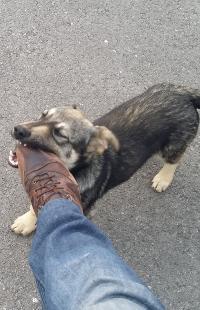Need guidance on E-stop/Disconnect Switch connections
- tommylight
-

- Away
- Moderator
-

Less
More
- Posts: 21019
- Thank you received: 7163
14 Nov 2022 11:24 #256678
by tommylight
Replied by tommylight on topic Need guidance on E-stop/Disconnect Switch connections
Yes, that looks OK.
The following user(s) said Thank You: Sray69
Please Log in or Create an account to join the conversation.
- Sray69
- Offline
- Elite Member
-

Less
More
- Posts: 255
- Thank you received: 13
14 Nov 2022 16:38 #256700
by Sray69
Replied by Sray69 on topic Need guidance on E-stop/Disconnect Switch connections
WOW! That is surprising. Maybe I am starting to understand.
Thanks for your assistance.
Thanks for your assistance.
The following user(s) said Thank You: tommylight
Please Log in or Create an account to join the conversation.
- snowgoer540
-

- Offline
- Moderator
-

Less
More
- Posts: 2513
- Thank you received: 847
15 Nov 2022 23:16 #256811
by snowgoer540
This does not look OK to me. If you lose power momentarily, there may be nothing stopping your machine from continuing on its way when power is restored. If a driver goes on the fritz, there's nothing killing the power to it.
Anyways, I don't know your application (commercial shop or hobby home based), but here's a schematic from Tormach: forum.linuxcnc.org/24-hal-components/439...stop?start=10#223294 C1 is a contactor. The one I used has 3 AC legs, and one DC leg. They are all NO I used the DC one to break the 24v circuit to the MESA card input.
I honestly dont know if they follow the ISO estop standards I've seen on other threads. But I will say that there are a ton of Tormach machines out there using this. Some in a small business setting, some hobbyist, and probably even a few commercial. Consider if that's good enough for your application.
Hope it helps.
Replied by snowgoer540 on topic Need guidance on E-stop/Disconnect Switch connections
tommylight,
Let me know what you think of this drawing. I came up with this iteration from another diagram I drew up that included a relay. I just removed the relay and rewired the E-stop.
I have 24V field power going through the NC side to a digital input. I am thinking this could work if I invert the state in HAL to "NOT". Does that sound right?
Also I fed the drivers using the 5V/GND from the unused stepgen on the Mesa. I ran the 5V through the NO side of the E-stop.
I would appreciate any help correcting my drawing.
drive.google.com/file/d/1n7JjQKnKvbeVyd4...j1N/view?usp=sharing
This does not look OK to me. If you lose power momentarily, there may be nothing stopping your machine from continuing on its way when power is restored. If a driver goes on the fritz, there's nothing killing the power to it.
Anyways, I don't know your application (commercial shop or hobby home based), but here's a schematic from Tormach: forum.linuxcnc.org/24-hal-components/439...stop?start=10#223294 C1 is a contactor. The one I used has 3 AC legs, and one DC leg. They are all NO I used the DC one to break the 24v circuit to the MESA card input.
I honestly dont know if they follow the ISO estop standards I've seen on other threads. But I will say that there are a ton of Tormach machines out there using this. Some in a small business setting, some hobbyist, and probably even a few commercial. Consider if that's good enough for your application.
Hope it helps.
Please Log in or Create an account to join the conversation.
- tommylight
-

- Away
- Moderator
-

Less
More
- Posts: 21019
- Thank you received: 7163
15 Nov 2022 23:32 #256812
by tommylight
Replied by tommylight on topic Need guidance on E-stop/Disconnect Switch connections
Snowwy, the DM860 he is using are stepper drives, no matter what happens to them the motors will not move, they can literally be on fire and motors will not move, just slowly burn.
Same goes for 3 phase DC servo systems, they do not move on drive failure. These can have software issues that can send the motors flying.
The only "unsafe" ones are brushed DC servo systems, on drive failure when outputs short, the motors will fly at full speed. On most of these, encoder issues will also send the motors flying.
New servo drives, better ones that is, have protections against loos of feedback.
Am i repeating this enough?
Same goes for 3 phase DC servo systems, they do not move on drive failure. These can have software issues that can send the motors flying.
The only "unsafe" ones are brushed DC servo systems, on drive failure when outputs short, the motors will fly at full speed. On most of these, encoder issues will also send the motors flying.
New servo drives, better ones that is, have protections against loos of feedback.
Am i repeating this enough?
The following user(s) said Thank You: snowgoer540
Please Log in or Create an account to join the conversation.
- snowgoer540
-

- Offline
- Moderator
-

Less
More
- Posts: 2513
- Thank you received: 847
15 Nov 2022 23:51 #256815
by snowgoer540
Replied by snowgoer540 on topic Need guidance on E-stop/Disconnect Switch connections
Perhaps, I'm just trying to say that electronics sometimes fail in wild and spectacular and unpredictable ways. Power surges do nifty things to them as well. A contactor is pretty cheap insurance to prevent mechanical equipment from being re-energized when you didn't intend for it to be de-energized under very unideal circumstances.
Please Log in or Create an account to join the conversation.
- Sray69
- Offline
- Elite Member
-

Less
More
- Posts: 255
- Thank you received: 13
16 Nov 2022 03:31 #256827
by Sray69
Replied by Sray69 on topic Need guidance on E-stop/Disconnect Switch connections
Thanks for the input Snowgoer. Tommy pointed out how the drivers are designed to keep the motors from running amuck if power is disrupted momentarily, which by the way is new to me as well. But I also plan to use a magnetic latching master on/off switch to my cabinet. It is my understanding that if power is disrupted the switch will stay off even if power comes back on, at least until I manually reset the switch. If this is correct, then all power to the CNC will stay OFF if power is disrupted.
Please correct me if I am wrong.
Please correct me if I am wrong.
Please Log in or Create an account to join the conversation.
- andypugh
-

- Offline
- Moderator
-

Less
More
- Posts: 19741
- Thank you received: 4579
17 Nov 2022 23:14 #256980
by andypugh
Replied by andypugh on topic Need guidance on E-stop/Disconnect Switch connections
Part of what Tommylight is saying is that it is quite hard to make a stepper motor turn, the driver has to switch the poles in complicated ways.
It's really unlikely for a failure mode to achieve motion.
It's really unlikely for a failure mode to achieve motion.
The following user(s) said Thank You: tommylight, snowgoer540, Sray69
Please Log in or Create an account to join the conversation.
- tommylight
-

- Away
- Moderator
-

Less
More
- Posts: 21019
- Thank you received: 7163
17 Nov 2022 23:58 #256991
by tommylight
Replied by tommylight on topic Need guidance on E-stop/Disconnect Switch connections
Sorry for failing to find a better way to explain that, but sometimes it takes a kick in the b#tt from someone, thank you Andy, to realize that. 
As soon as i read Andy's reply, it dawned on me that i could do it better, i hope:
--Take a battery, 1.5V or 3.7V or 12V and
-wire it to any stepper motor wires = it will not spin, made to work with pulses
-wire it to 3 phase motors = do not spin, made to work with pulses
-wire it to Brushed DC = they spin as they are made to work like this.
-- No matter how much DC voltage you push through the first two, they do not spin, they will burn, but not spin.
-- All drives, be it AC or DC powered ones will convert to DC and the output stages on all types of drives work under DC power, so when they fail the output will be DC power
-- From the above it is easy (yeaaah riteee ) to conclude that the first two types have no way of moving when output transistors fail, so require less safety features.
) to conclude that the first two types have no way of moving when output transistors fail, so require less safety features.
Is this a better explanation?
Feel free to critique when i mess up explanations, i would really appreciate that.
Thank you.
As soon as i read Andy's reply, it dawned on me that i could do it better, i hope:
--Take a battery, 1.5V or 3.7V or 12V and
-wire it to any stepper motor wires = it will not spin, made to work with pulses
-wire it to 3 phase motors = do not spin, made to work with pulses
-wire it to Brushed DC = they spin as they are made to work like this.
-- No matter how much DC voltage you push through the first two, they do not spin, they will burn, but not spin.
-- All drives, be it AC or DC powered ones will convert to DC and the output stages on all types of drives work under DC power, so when they fail the output will be DC power
-- From the above it is easy (yeaaah riteee
Is this a better explanation?
Feel free to critique when i mess up explanations, i would really appreciate that.
Thank you.
The following user(s) said Thank You: snowgoer540, Sray69
Please Log in or Create an account to join the conversation.
- Sray69
- Offline
- Elite Member
-

Less
More
- Posts: 255
- Thank you received: 13
18 Nov 2022 00:52 #256996
by Sray69
Replied by Sray69 on topic Need guidance on E-stop/Disconnect Switch connections
I can tell you from someone who know very little about this, that makes perfect sense. Thanks for the detailed explanation.Sorry for failing to find a better way to explain that, but sometimes it takes a kick in the b#tt from someone, thank you Andy, to realize that.
As soon as i read Andy's reply, it dawned on me that i could do it better, i hope:
--Take a battery, 1.5V or 3.7V or 12V and
-wire it to any stepper motor wires = it will not spin, made to work with pulses
-wire it to 3 phase motors = do not spin, made to work with pulses
-wire it to Brushed DC = they spin as they are made to work like this.
-- No matter how much DC voltage you push through the first two, they do not spin, they will burn, but not spin.
-- All drives, be it AC or DC powered ones will convert to DC and the output stages on all types of drives work under DC power, so when they fail the output will be DC power
-- From the above it is easy (yeaaah riteee) to conclude that the first two types have no way of moving when output transistors fail, so require less safety features.
Is this a better explanation?
Feel free to critique when i mess up explanations, i would really appreciate that.
Thank you.
The following user(s) said Thank You: tommylight
Please Log in or Create an account to join the conversation.
Moderators: PCW, jmelson
Time to create page: 0.074 seconds
